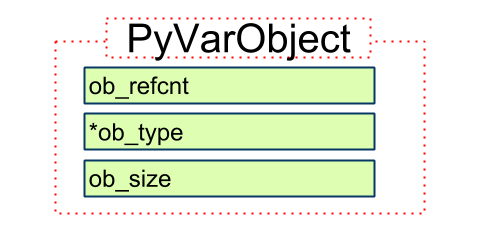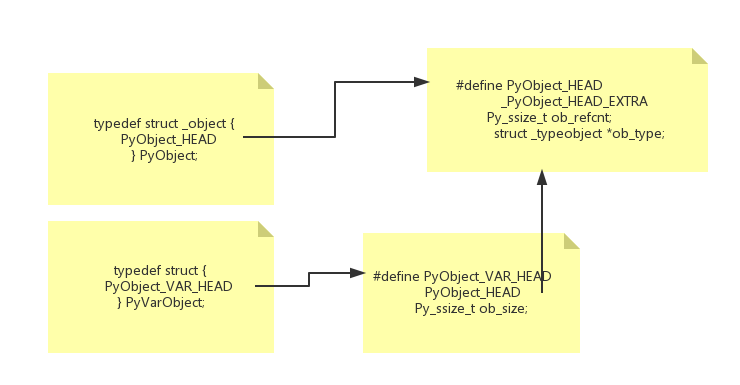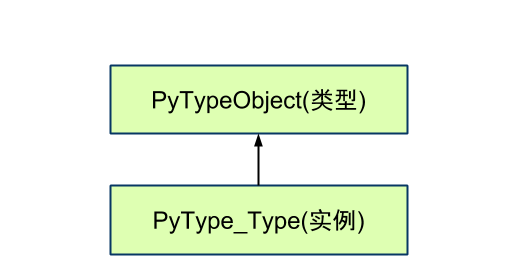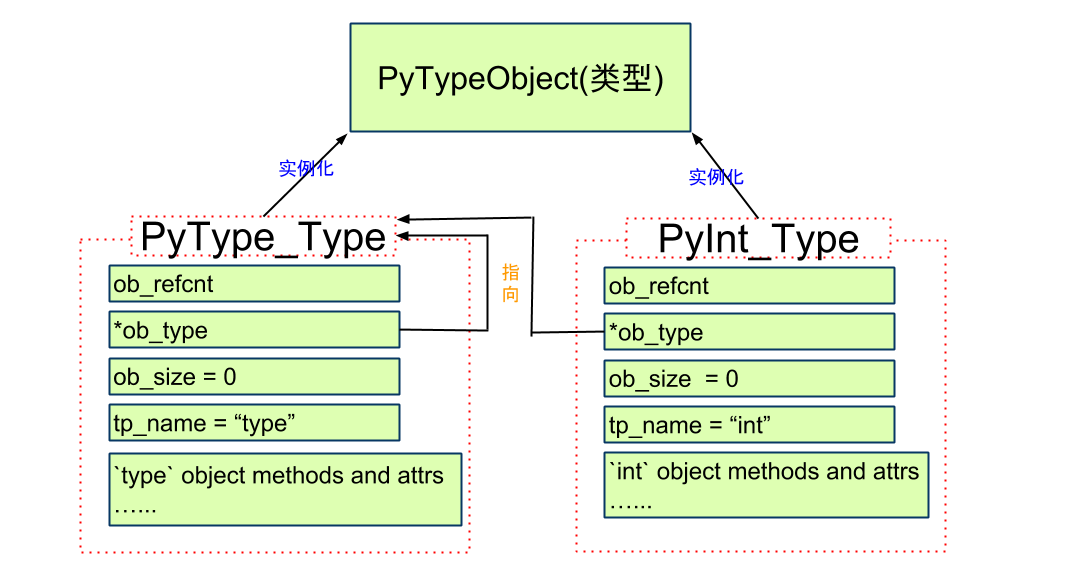深入源码解析Python中的对象与类型
来源:互联网 发布:java interrupt sleep 编辑:程序博客网 时间:2024/05/18 03:39
http://www.jb51.net/article/76269.htm
对象
对象, 在C语言是如何实现的?
Python中对象分为两类: 定长(int等), 非定长(list/dict等)
所有对象都有一些相同的东西, 源码中定义为PyObject和PyVarObject, 两个定义都有一个共同的头部定义PyObject_HEAD(其实PyVarObject有自己的头部定义PyObject_VAR_HEAD, 但其实际上用的也是PyObject_HEAD).
源码位置: Include/object.h
PyObject_HEAD
Python 内部, 每个对象拥有相同的头部.
定义
/*PyObject_HEAD defines the initial segment of every PyObject.*/#define PyObject_HEAD \ _PyObject_HEAD_EXTRA \ Py_ssize_t ob_refcnt; \ struct _typeobject*ob_type;说明
1. _PyObject_HEAD_EXTRA
先忽略, 双向链表结构, 后面垃圾回收再说
2. Py_ssize_t ob_refcnt
Py_ssize_t在编译时确定, 整型
ob_refcnt, 引用计数, 跟Python的内存管理机制相关(基于引用计数的垃圾回收)
3. struct _typeobject *ob_type
*ob_type 指向类型对象的指针(指向_typeobject结构体)
决定了这个对象的类型!
PyObject
定义
typedef struct _object { PyObject_HEAD} PyObject;说明
1. 依赖关系
PyObject -> PyObject_HEAD
结构

PyVarObject
定义
typedef struct { PyObject_VAR_HEAD} PyVarObject;#define PyObject_VAR_HEAD \ PyObject_HEAD \ Py_ssize_t ob_size;/* Number of items in variable part */说明
1. 依赖关系
PyVarObject -> PyObject_VAR_HEAD -> PyObject_HEAD
2.Py_ssize_t ob_size
ob_size, 变长对象容纳的元素个数
结构


几个方法
跟对象相关的方法
#define Py_REFCNT(ob) (((PyObject*)(ob))->ob_refcnt)
读取引用计数
#define Py_TYPE(ob) (((PyObject*)(ob))->ob_type)
获取对象类型
#define Py_SIZE(ob) (((PyVarObject*)(ob))->ob_size)
读取元素个数(len)
跟引用计数相关的方法
Py_INCREF(op) 增加对象引用计数
Py_DECREF(op) 减少对象引用计数, 如果计数位0, 调用_Py_Dealloc
_Py_Dealloc(op) 调用对应类型的 tp_dealloc 方法(每种类型回收行为不一样的, 各种缓存池机制, 后面看)
其他
几个参数涉及
ob_refcnt 引用计数, 与内存管理/垃圾回收相关
ob_type 类型, 涉及Python的类型系统
类型
一个例子
>>> a =1>>> a1>>> type(a)<type'int'>#等价的两个>>> type(type(a))<type'type'>>>> type(int)<type'type'>#还是等价的两个>>> type(type(type(a)))<type'type'>>>> type(type(int))<type'type'>我们反向推导一个int对象是怎么生成的.
1. 首先, 定义一种类型叫PyTypeObject
代码位置 Include/object.h
定义
typedef struct _typeobject { /*MARK: base, 注意, 是个变长对象*/ PyObject_VAR_HEAD const char*tp_name; /*For printing, in format "<module>.<name>" */ //类型名 Py_ssize_t tp_basicsize, tp_itemsize;/* For allocation */// 创建该类型对象时分配的内存空间大小 //一堆方法定义, 函数和指针 /*Methods to implement standard operations */ printfunc tp_print; hashfunc tp_hash; /*Method suites for standard classes */ PyNumberMethods*tp_as_number; // 数值对象操作 PySequenceMethods*tp_as_sequence; // 序列对象操作 PyMappingMethods*tp_as_mapping; // 字典对象操作 //一堆属性定义 ....} PyTypeObject;说明
1. PyObject_VAR_HEAD
变长对象
2. const char *tp_name
tp_name, 类型名字符串数组
所有Type都是PyTypeObject的"实例": PyType_Type/PyInt_Type
2. 然后, 用PyTypeObject初始化得到一个对象PyType_Type
代码位置 Objects/typeobject.c
定义
PyTypeObject PyType_Type= { PyVarObject_HEAD_INIT(&PyType_Type,0) "type", /* tp_name */ sizeof(PyHeapTypeObject), /* tp_basicsize */ sizeof(PyMemberDef), /* tp_itemsize */ (destructor)type_dealloc, /* tp_dealloc */ //type对象的方法和属性初始化值 .....};说明
1. tp_name
类型名, 这里是"type"
2. PyVarObject_HEAD_INIT(&PyType_Type, 0)
PyVarObject_HEAD_INIT, 这个方法在 Include/object.h中,
等价于
ob_refcnt = 1
*ob_type = &PyType_Type
ob_size = 0
即, PyType_Type的类型是其本身!
结构
第一张图, 箭头表示实例化(google doc用不是很熟找不到对应类型的箭头)

第二张图, 箭头表示指向

使用
# 1. int 的 类型 是`type`>>> type(int)<type'type'># 2. type 的类型 还是`type`, 对应上面说明第二点>>> type(type(int))<type'type'>注意: 无论任何时候, ob_type指向的是 PyTypeObject的实例: PyType_Type/PyInt_Type...
3. 再然后, 定义具体的类型, 这里以PyInt_Type为例子
代码位置 Objects/intobject.c
定义
PyTypeObject PyInt_Type= { PyVarObject_HEAD_INIT(&PyType_Type,0) "int", sizeof(PyIntObject), 0, //int类型的相关方法和属性值 .... (hashfunc)int_hash, /* tp_hash */};说明
1. "int"
PyInt_Type的类型名是int
2.PyVarObject_HEAD_INIT(&PyType_Type, 0)
PyInt_Type的
*ob_type= &PyType_Type结构

使用
>>> type(1)<type'int'>>>> type(type(1))<type'type'>4. 最后, 生成一个整数对象int
代码位置 Include/intobject.h
定义
typedef struct { PyObject_HEAD longob_ival;} PyIntObject;
- 深入源码解析Python中的对象与类型
- 1 Python中的类型与对象
- 深入解析C++中的引用类型
- 深入解析C++类对象的赋值复制与类型转换
- 深入解析Python中的WSGI接口
- 深入理解Python中的面向对象
- 深入解析RxJava源码(一)Observable对象的构建
- python中的对象与参考
- python中的类与对象
- 深入解析printf/spintf/snprintf中的类型转换
- 深入解析printf/spintf/snprintf中的类型转换
- Python对象类型判断与函数重载
- 深入源码解析Android中的Handler,Message,MessageQueue,Looper
- 深入源码解析Android中的Handler,Message,MessageQueue,Looper
- 深入源码解析Android中的Handler,Message,MessageQueue,Looper
- 深入源码解析Android中的Handler,Message,MessageQueue,Looper
- 深入源码解析Android中的Handler,Message,MessageQueue,Looper
- JDK8 中的类型推断与重载解析
- Python中配置matplotlib模块
- C语言:strcpy()
- codingbat:recursion-2:1(JAVA)
- 动态内存分配
- NSURLConnection — GET请求的第二种方式
- 深入源码解析Python中的对象与类型
- Linux系列-安装常用软件
- 字节对齐--编码就得多思考
- vim 7.4同时支持python 2.x和3.x问题调研
- 数位思想
- copy内存管理...
- 2015 总结 & 2016 展望
- 树莓派关于重新安装raspdeian连不上问题
- tomcat的web.xm文件配置


